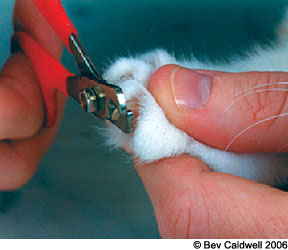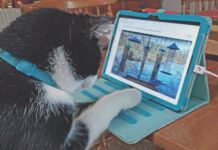Years ago, it seemed that, unless people planned to let their cats go outside, the cats were likely to be declawed. Thankfully, veterinarians and cat owners alike have learned that indoor cats can live happily ever after with claws intact – and that there is no reason for these clawed cats to inflict damage on people, other pets or furniture.
But as you know, even the most well-intentioned cat can cause damage. If you have ever had a cat leap off your bare lap in a hurry, you know what the consequences can be. And those of us with hardwood floors know that frisky felines can wreak havoc on the finish.
What to do? Keep the claws trimmed short, of course. That can be easier said than done, however. Certainly, some cats simply sit quietly and tolerate virtually any procedure. Those are the cats that lie quietly as mats are trimmed, or burrs removed. But what if you happen to live with the other kind of cat – the one that sets limits, and lets you know just how many strokes of the brush you may inflict without being swatted, or even bitten?

288
There is hope for even the most determined cat. Through a desensitization and counterconditioning process, most cats can be encouraged to tolerate having their claws trimmed.
There are several strategies that may be used. In all cases, behavior modification must progress slowly and systematically. Since we are dealing with aggression, it would be best to have a qualified behaviorist help you select the strategy that is most suited for your own cat.
By definition, a desensitization technique is one that exposes the cat to a stimulus at a low enough intensity that arousal and reactivity are minimal. Your cat should return to a calm mood before the lesson for the day has been completed. If your cat becomes very aggressive, of course you may need to abandon the lesson for the sake of safety.
However, be prepared that the next lesson will likely be more difficult. Overall progress is always hindered when you need to abort in mid-session.
Keep Yourself Safe from Harm
The first step in working with your cat is to determine a way to assure that you will not be injured. At the very least, some gentle restraint will be needed. Providing some restraint will allow you to concentrate on the task at hand. A heavy towel can be used to assure safety. Have your veterinarian demonstrate the proper toweling technique for your cat.
For the first few lessons, just wrap the cat and give a gentle squeeze and a treat. As long as the cat is eager for another treat and not struggling, you may give him a treat and release him. Once he tolerates the towel, try to wrap him, give him a treat and then hold a paw before giving the next treat. If your cat is calm enough, you might even trim the tip of one single claw. If there is too much fussing, skip the trim and just gently squeeze the toe to expose the claw. Then give treats liberally, allow your cat to fully relax and then let him walk away. The next day, do another claw.
What if your cat does bite or scratch when handled? You may need to begin by desensitizing your cat to a restraint system. Cat bags are commercially available and are well tolerated by many cats. Encourage your cat to enter and explore the bag by placing treats or toys inside. Hold the bag open so the cat is not trapped. Leave the small windows on the side of the bag unzipped. Do not attempt any restraint until your cat is clearly eager to jump into the bag. It may take many weeks before you are ready to zip the bag and all of the small portholes closed, so take your time. Once you have your cat safely restrained, you may accomplish a trim quickly and safely.
Of course, your cat will not jump into the bag regularly if he thinks the result is a claw trim. For every trim, plan four or five bag games. For these games, hide the treats and just zip him in and let him have his treats, then back out he goes. You will need some very delicious treats, of course.
Please do not feel that you have failed your cat if you are unable to trim his claws. Veterinarians and their staff trim hundreds of claws per day and are quite adept at this task. When needed, safe sedatives might be used to assure that neither cat nor person is subjected to undue stress or injury.



